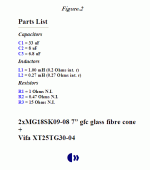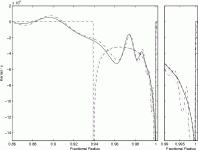Thanks for all this Inductor! Where did you get these plans from? Looks like something I would like to implement especially since I will be biwiring. I got the Vifa midrange drivers from a friend who had 4 extras. Also I suspect that the XT25 will need impedance compensation as sreten suggested.
audio_moksha said:Thanks for all this Inductor! Where did you get these plans from? Looks like something I would like to implement especially since I will be biwiring. I got the Vifa midrange drivers from a friend who had 4 extras. Also I suspect that the XT25 will need impedance compensation as sreten suggested.
"As is". You are free to experiment... I don't think it will need one. Why do you suspect? You can always change it if you don't like. It's also padded by the L-pad.
Accoustic xover ~2K0.
audio_moksha said:Thanks for all this Inductor! Where did you get these plans from? Looks like something I would like to implement especially since I will be biwiring. I got the Vifa midrange drivers from a friend who had 4 extras. Also I suspect that the XT25 will need impedance compensation as sreten suggested.
Hi,
Impedance compensation would more of an issue if the c/o had
significant attenuation (therefore high source impedance), as it
is attenuation is minimal and the impedance peak is "buffered"
somwhat by the 15R resistor.
see ZD5, for accurate low Q slopes the tweeter needs a LCR.
Inductor's c/o values seem to be in the right ballpark but
it would be interesting to know how they are derived.
The bass mid driver wiggle at 1kHz would be an issue for me,
as would the amount of baffle step compensation, the tweeter
level indicates to me not enough BSC.
🙂/sreten.
sreten said:
... as would the amount of baffle step compensation, the tweeter
level indicates to me not enough BSC.
Check again with two speakers (2xMG18). You can adjust on the compensantion/attenuation circuit of the tweeter if you don't like the desired computed attenuation (~3dB).
audio_moksha, take special care on the inductor L1, at full operational use you should get a double power inductor for the pair of two speakers, or double the diametre of cable in it (inductor). Also choose a low loss or internal resistence inductor like the Tritecs Ferrobars or similar.
I guess the best thing to do would be to take actual measurements. So are both hi and lo pass filters 2nd order LR?
sreten said:Hi,
Nominal tweeter attenuation appears to be 1.2dB.
🙂/sreten.
I measured at around overlap frequency (~3dB@2K0). It might differ over bandpass. It's important for balanced overall.
audio_moksha said:I guess the best thing to do would be to take actual measurements. So are both hi and lo pass filters 2nd order LR?
Woofer is a 1st order (inductor L1) with a R-C Zobel.
Zobel here
http://www.trueaudio.com/st_zobel.htm
Tweeter is second order.
The transfer output from this xover (electrical) is very similar to what the picture of fig.3 shows on the stereophile document. The summation of both (electrical/output of the drivers per si and room conditions) will give your final result.
Interesting to note how the peak from the woofer after 1K/2K is brougth down by the xover (in a very similar way to this picture) and blends with the tweeter.
Attachments
Inductor and sreten, I cannot thank you enough for going out of your way and helping out a beginner I can only hope that in time I get to be as knowledgabe as you guys and in turn help someone else out. I have a lot of homework this week (almost done with college~!) but this weekend I will hopefully take some measurements using SW as well as build the cabinets.
Congratulations!
You are welcome. You are very fast with your work. Faster than you maybe only Mr. Lipinski. And a nice designer for sure. I admire his padding around the tweeters (you don't have so many problems with differences in phase when you go high in frequency) like so many others. Expect to see some pictures. This his only a prototipe. Maybe one day we can compare our (your) work to the real network.
You are welcome. You are very fast with your work. Faster than you maybe only Mr. Lipinski. And a nice designer for sure. I admire his padding around the tweeters (you don't have so many problems with differences in phase when you go high in frequency) like so many others. Expect to see some pictures. This his only a prototipe. Maybe one day we can compare our (your) work to the real network.
i'm actually building these for monitoring purposes. My first calling is pro audio. Have any suggestions for the tweeter surround. I figure I need something that is more of an acoustical barrier and less of an absorber. I was considering whispermat. Any suggestions on that end?
Hi steren BSC
your explain about acoustic filter that i don't know why too long so much=very much(lol) acoustic filter= natural roll off by itself. i surprise why u think so far away.😀
your explain about acoustic filter that i don't know why too long so much=very much(lol) acoustic filter= natural roll off by itself. i surprise why u think so far away.😀
Thawach said:Hi steren BSC
your explain about acoustic filter that i don't know why too long
so much=very much(lol) acoustic filter= natural roll off by itself.
i surprise why u think so far away.😀
Hi,
If you are saying the penny has dropped - good.
If you are saying something else I cannot work what that is.
🙂/sreten.
hi,
have a look at the Calvini in this thread: http://www.diyaudio.com/forums/showthread.php?s=&threadid=74301&highlight=
This design gives 3dB higher efficiency, doesn´t need a notch for the mid-woofers (just an inductor to control dispersion mainly) and the positioning of the tweeter by the horn is perfect for the step response. Too the tweeter sounds smoother but more dynamic and shows considerably less distortion. It features a superior cabinet, made from granite and wood.
Besides I like the looks far more than the Lipinskis.
jauu
Calvin
have a look at the Calvini in this thread: http://www.diyaudio.com/forums/showthread.php?s=&threadid=74301&highlight=
This design gives 3dB higher efficiency, doesn´t need a notch for the mid-woofers (just an inductor to control dispersion mainly) and the positioning of the tweeter by the horn is perfect for the step response. Too the tweeter sounds smoother but more dynamic and shows considerably less distortion. It features a superior cabinet, made from granite and wood.
Besides I like the looks far more than the Lipinskis.
jauu
Calvin
audio_moksha said:i'm actually building these for monitoring purposes. My first calling is pro audio. Have any suggestions for the tweeter surround. I figure I need something that is more of an acoustical barrier and less of an absorber. I was considering whispermat. Any suggestions on that end?
http://www.silentsource.com/barriers-whispermat.html
It seems to be a good acoustic product, if you know how to make it right with looks and finishings. The originals seem to have that sponge/foam side exposed, I don't know if they are hard or soft formers. Maybe a foam/barrier composite is not a good choice in this case. A good product, though.
C3 from Post #21 was never used, it came from somewhere else. Components values where recheked by me. Have in mind that this xover was never used as is, and it might have to be tested first. You might end with different values in a final version. Thanks.
i'll take Thanks Inductor. Once I build it, I'll take some standard measurements using speaker workshop. Then I can take it on from there
If there is a dip in the xover region we can recheck everything again, but it's very much like the "original one" in Stereophile, at least with similar results, you know, the rool overs and atten. at 2K and peak from the woofer at this frequency with also the tweeter "integration". Check if the tweeter is "at your level" in output from to 2k~5K where the woofer falls or to low, and then the balance of the overall.
I also checked the time alignment using speaker workshop and it appears to be pretty acceptable at about .03ms time lag between the woofer and tweeter. I had both tweeter and woofer hooked up in phase and measured from the same distance. I just moved the mic up and down to align it with the respective driver at a distance of about 3 inches.
The chart legend is wrong; the red trace is Vifs MG25 mid range and the black trace is the XT25 and therefore, the mid range is about .03ms behind the tweeter
The chart legend is wrong; the red trace is Vifs MG25 mid range and the black trace is the XT25 and therefore, the mid range is about .03ms behind the tweeter
Attachments
As far as the construction is concerned, I used a nice figured AAA veneer and tomorrow I'm going to spray it with clear laquer. Jason Flanary of Love Craft Designs (Formerly Cain & Cain) has been such a great help to me. I owe him a big debt for letting mw use his shop equipment.
lovecraftdesigns.com
lovecraftdesigns.com
- Status
- Not open for further replies.
- Home
- Loudspeakers
- Multi-Way
- MTM project using 7" vifa drivers



